Crayfish, crawfish, crawdad, yabby, lobster…There are as many names as there are species of these fascinating crustaceans! Crayfish are pretty common in the aquarium trade and come in some dazzling color morphs, from camouflaged green to electric blue!.
Some are an inch long fully grown while others approach a foot long! And all are personable and more than willing to use their massive pinchers! Let’s get to know aquarium Crayfish a little better!
What Are Crayfish?
Crayfish look similar to saltwater lobsters and in many parts of the world the names Crayfish and Lobster are interchangeable.
As members of the infraorder Astacidea they are indeed close cousins to lobsters and inhabit much the same ecological niche. Crayfish are bottom dwelling opportunists and scavengers that will eat nearly anything organic.
Animal or plant, living or dead, it makes little difference to Crayfish so long as it can’t fight back. Some are even cannibalistic, feeding on their own kind if caught while soft and vulnerable during a molt.
Crayfish are found all over the world and are a valuable food source. Even the popular Louisiana Crayfish, often found in aquariums, are eaten with gusto, especially in the United States!
Types of Aquarium Crayfish
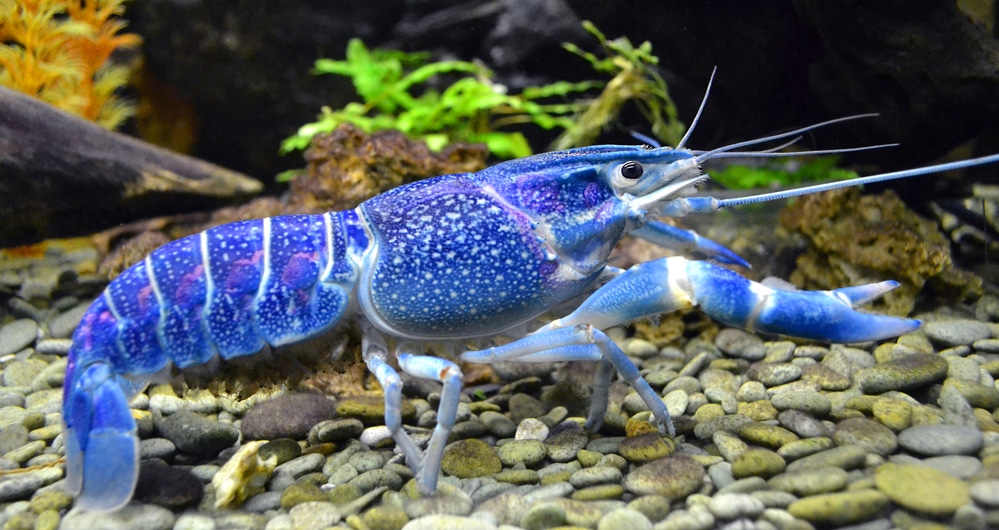
Crayfish are a very diverse group but there are three ways to categorize the most common types of aquarium Crayfish!
Dwarf Crayfish (Cambarellus sp.)
There are a few dozen Dwarf Crayfish species scattered across the Gulf Coast of Mexico and the United States but only a couple are found in the aquarium hobby with any frequency.
Cambarellus patzcuarensis has several common names, including Dwarf Orange, Mexican Orange, and CPO Crayfish (referring to the first letters of its genus and species latin name + orange).
The Blue Brazos Crayfish (Cambarellus texanus) is much rarer but being tank bred more frequently now. Both species are threatened in the wild. Captive bred specimens are not only better for the environment but better in color since the wild types of both species are a drab grey.
Truly, Dwarf Crayfish are American Crayfish writ small – eager omnivores looking for smaller prey to grab onto. Thankfully, there aren’t many tank mates small enough to be overpowered and eaten by Dwarf Crayfish, which makes them excellent for most community aquariums.
- Scientific Name: Cambarellus sp.
- Origin: Mexico and Southeastern USA
- Size: 1 to 2 inches
- Difficulty: Easy
American Crayfish (Procambarus sp.)
The American Crayfish group includes the red Louisiana Crayfish (Procambarus clarkii) which often shows up in restaurants and grocery stores as “Crawfish,” or “Crawdads.” As popular as this species is to raise in large numbers several color morphs exist, including bright white Ghost and Neon Red Crayfish.
American Crayfish are simultaneously some of the easiest and most difficult aquarium Crayfish to keep. They are extraordinarily hardy and tolerate a wide range of water conditions, including factory pollution, low oxygen, and even drought spells in mud burrows so long as they are kept moist. They will eat anything organic with relish, including prepared foods and dead plants.
However they are famously aggressive and will latch onto anything they can to feed or fight. Small fish will eventually be snagged and eaten and even larger fish can be wounded by their long claws or latched onto while sleeping to be eaten alive.
And fish large enough to not be threatened by them will usually turn the tables and simply eat the Crayfish. They will even eat each other if they catch a partner when their shell is still soft from moulting!
Florida or Blue Crayfish Procambarus alleni are a closely related but separate species. In the wild they are usually a mottled brown and green however the electric blue morph is by far the most common in the trade. Like the Louisiana Crayfish they are eager eaters but aggressive tank inhabitants.
- Scientific Name: Procambarus sp.
- Origin: Eastern United States
- Size: 3 to 5 inches
- Difficulty: Very Easy
Freshwater Lobsters (Cherax sp.)
Cherax Crayfish are a bit of a mixture in terms of taxonomy as they represent several closely related species, subspecies, and color morphs. Found throughout Papua New Guinea and Australia these are some of the largest Crayfish in the world save a few larger (and much rarer) species such as the Tasmanian Giant Crayfish.
Freshwater Lobsters can reach up to a foot in length, depending on the species in question. 6 to 8 inches is more common for these Crayfish, however.
The Zebra Lobster (Cherax peknyi) may be the most commonly seen species and are tank raised in several attractive color morphs, from pastel blue and orange to dark purple and red. Others include the jet black Papua Lobster and the Australian Common Yabby (Cherax destructor), often raised for food like the Louisiana Crayfish.
- Scientific Name: Cherax sp.
- Origin: Papua New Guinea and Australia
- Size: 8 to 12 inches
- Difficulty: Easy to Moderate
Aquarium Crayfish Care
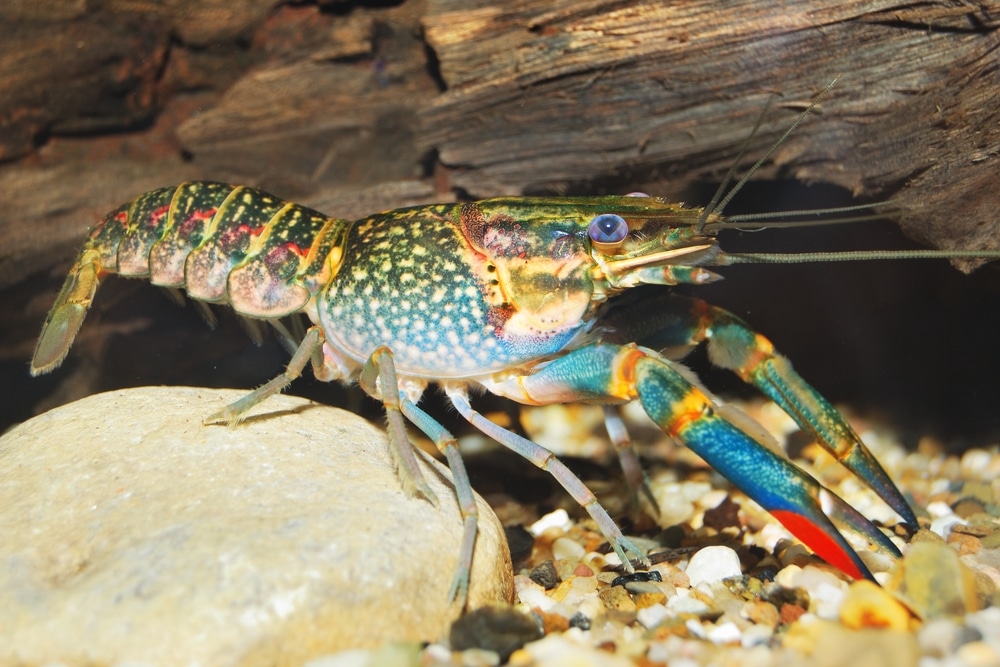
Here is everything you need to know about aquarium crayfish care:
Aquarium Size for Crayfish
Tank size for Crayfish is important not only for them but their tank mates as well. When keeping medium to large species you should offer plenty of swimming room so fish can avoid being grabbed onto. Larger aquariums also offer more volume for buffering sudden swings in temperature, pH, ammonia levels, etc.
Dwarf Crayfish can be kept in aquariums as small as 5 gallons. American Crayfish do well in aquariums from 10 gallons on up and adult Freshwater Lobsters should have a minimum of 30 gallons of space due to both their size and slight sensitivity to poor water conditions.
Water Quality
Most Crayfish are not especially sensitive in terms of water quality but they aren’t too tolerant of poor conditions, either. The sole exception is the Louisiana Crayfish (Procambarus clarkii) which can tolerate moderate levels of pollution and wide temperature swings.
Like all invertebrates Crayfish are rather sensitive to nitrate levels. Many aquarium fish can tolerate 20 to 40ppm before showing signs of distress however you should always be aiming for 0ppm when keeping invertebrates.
Ammonia and nitrite should also be at or close to 0ppm. This is especially important for Cherax Freshwater Lobsters and many of the rarer, wild-caught Dwarf and American Crayfish, which can on the sensitive side.
Temperatures vary considerably for Crayfish. The North American Dwarf and Procambarus species can tolerate cooler temperatures down to 65F. However most Freshwater Lobsters are all tropical species and should be kept at 75-82F. The Australian Yabby (Cherax destructor) is an exception and can be kept in cooler waters without issue!
The pH should be neutral to slightly alkaline as well (7.0-8.0). Acidic waters make it hard for Crayfish to maintain the integrity of their shells.
Plants and Substrate
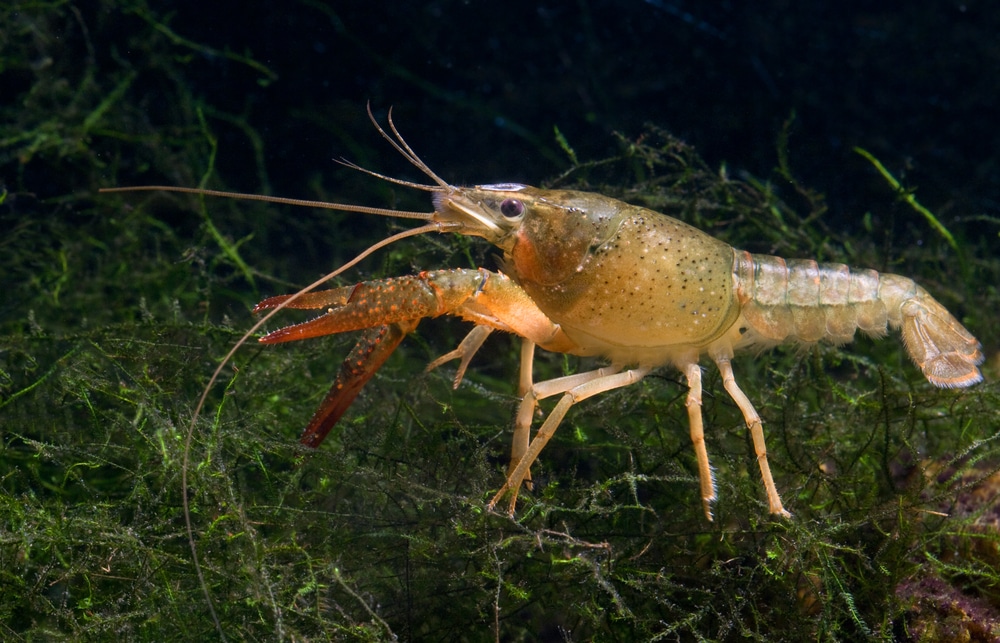
As omnivores that will readily eat plant matter, choosing the right plants can be difficult when keeping Crayfish. Dwarf Crayfish are the most plant safe type, nibbling delicately on Java Moss and other soft, filamentous species but never enough to do lasting harm.
The larger Crayfish are difficult to keep in a planted aquarium, especially the burrowing, vegetarian heavy Freshwater Lobsters. Plants that attach directly to rocks and driftwood like Anubias, Java Fern, and African Water Fern offer several advantages.
They can’t be uprooted by digging, they are low light tolerant and can thrive in aquariums not set up for most plants, and they tend to have tough, bitter tasting leaves. A determined Lobster may still decide to snack on even hard to reach Anubias but can usually be distracted with fresh and blanched vegetables.
In terms of substrate Crayfish are mostly non picky when it comes to soil, sand, or gravel. However they will dig to some degree and prefer to construct burrows against driftwood, rocks, and glass if the substrate allows for it.
Feeding Aquarium Crayfish
Feeding Crayfish is one of the easiest things about keeping them alive because they will eat nearly anything you offer them! Soft plants like Elodea, sinking pellets, flakes, and other prepared foods, fresh and frozen foods, and the occasional live snack are all happily accepted.
While Crayfish can scavenge to find their own food they are much more aggressive and willing to hunt tank mates when hungry and forced to fend for themselves. Regular feedings also encourages molts and eventual breeding when keeping Crayfish in groups!
Freshwater Lobsters lean more heavily on the vegetarian side and enjoy blanched peas, grated carrot, spinach, and other easily grasped vegetables, supplemented with worms, frozen food cubes, and prepared foods.
When Crayfish Molt
Like many invertebrates with exoskeletons Crayfish need to periodically shed their shells because the hard, inflexible outer layer can’t grow along with their insides.
Crayfish molt 6 to 10 times in their first year of life, slowing down over the years as they mature. Knowing when Crayfish are about to molt is challenging but here are a few key signs:
- Spends all day within the burrow
- Avoids feeding
- Relatively inactive and motionless
Crayfish need to gather energy before the exhausting molting procedure and will act in ways that appear similar to some sort illness. The molt itself takes anywhere from minutes to hours and once complete the Crayfish usually eats the cast-off shell to replenish lost minerals.
Molting is dangerous because Crayfish are soft for a short period until their new shells harden. Fish find these soft bodied Crayfish delectable and even normally unthreatening fish can easily rip off a leg or claw in this defenseless state.
Even other Crayfish are a threat to a freshly molted specimen however they usually remain in their burrows until their shells fully harden.
Tank Mates for Aquarium Crayfish
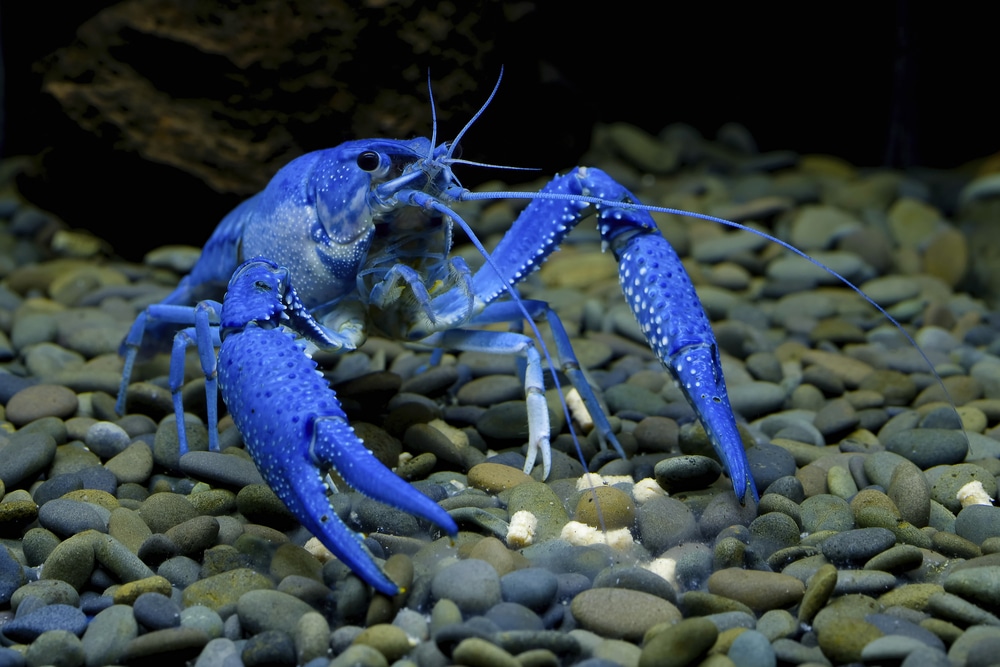
Given their opportunistic nature this can be one of the most challenging aspects of keeping aquarium Crayfish! Dwarf Crayfish are the easiest while American and Freshwater Lobsters are harder to place.
Dwarf Crayfish Tank Mates
With an adult size of 1 to 2 inches Dwarf Crayfish are too slow and small to threaten most aquarium inhabitants. They can be kept with most community fish, including tetras and livebearers. And they will defend themselves against Barbs and other fish known to pick at antennae or limbs.
Dwarf Crayfish can even be kept with Freshwater Shrimp, Snails, and other invertebrates. They will eat baby Shrimp and Snails if they can catch them as well as weak, sick, or dying invertebrates and fish, however.
American Crayfish Tank Mates
As common as they are in the trade American Crayfish aren’t always the best community residents. They are just large enough to threaten most aquarium fish and will overpower and eat anything they can catch, live or dead.
Mid water to surface dwelling fish like Tetras, Rasboras, and Danios are best while bottom dwellers like Corydoras and Plecos should be avoided entirely. Even Plecos too large to be eaten may suffer a nasty pinch if they wander too close to a Crayfish burrow.
Keeping your American Crayfish well fed with a mixture of plant and animal matter greatly reduces their aggressive tendencies. When forced to scavenge they are much less picky about their prey.
Freshwater Lobster Tank Mates
Like American Crayfish Freshwater Lobsters are a danger to slow moving and bottom dwelling fish. Inhabitants that stay away from the bottom will do well even if they are small – Hatchetfish, Tetras, and Rainbowfish can all be kept with Freshwater Lobsters.
Bottom dwellers and other invertebrates are best avoided. Larger cichlids and large invertebrates like Vampire Shrimp and other Cherax Crayfish can also work so long as you feed them regularly and offer enough space for each species to claim territory and burrow.
Burrowing space is especially important when the Freshwater Lobster is molting as they are a tasty, expensive snack for large fish if caught exposed and soft shelled.
Breeding Aquarium Crayfish
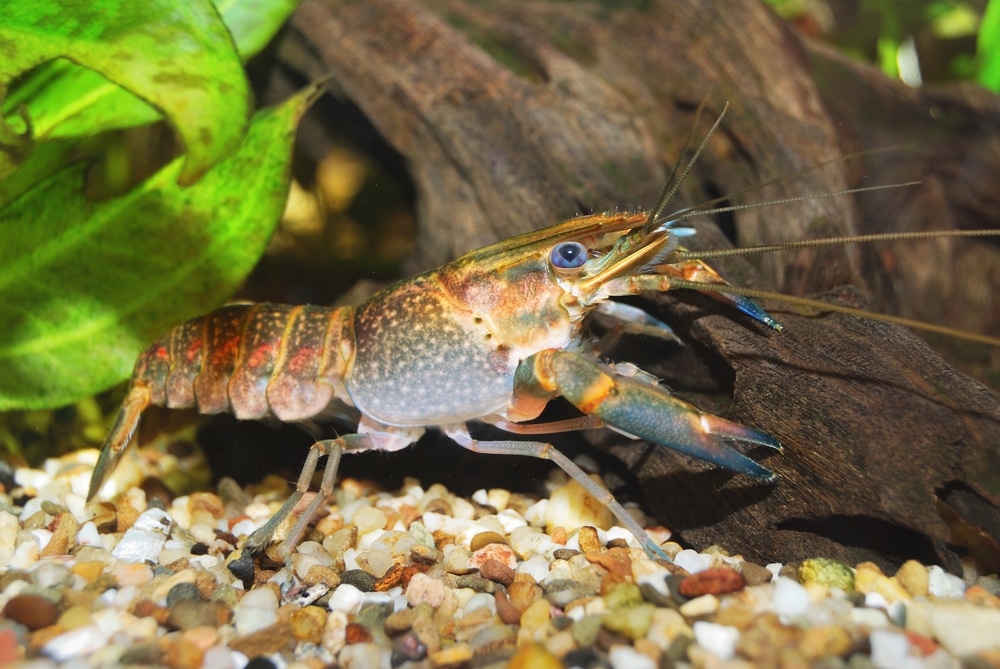
Breeding aquarium Crayfish is both rewarding and necessary because it takes pressure off of wild stocks. Dwarf Crayfish and Freshwater Lobsters are also relatively uncommon in the trade and captive bred specimens can fetch a good price in stores and trade shows!
Sexing Aquarium Crayfish
Telling males from females is a little challenging because you need to remove them from the water to get a closer look. Specifically, you’re looking at the pleopods or swimmerets beneath the tail that Crayfish use for swimming aids.
Males have a rigid first set right behind their fourth pair of legs that are called gonopods. These specialized limbs are used during mating to pass sperm to the female. Females lack these hardened gonopods and instead rely on their swimmerets to carry eggs and newly hatched babies underneath their tail.
Conditioning and Breeding Aquarium Crayfish
Once you have determined the sex of your Crayfish breeding is a simple affair! Simply provide a rich, varied diet of plant and animal matter with supplemental prepared foods and a warm environment! Make sure nitrates are as close to 0ppm as possible and that the male and female are roughly equal in size.
Eventually the female will “berry:” fertilized eggs will appear under her abdomen, a sign of a successful mating! The male should either be removed or have his claws rubber banded to keep from harassing her or eating the eventual newborn Crayfish.
Crayfish eggs develop underneath the female’s tail over the course of a month. The young eventually hatch and with many Crayfish species the female will guard the young for up to a week, guiding them to food and waving away potential predators.
Raising Young Aquarium Crayfish
In community aquariums it’s better to capture the female once the eggs hatch and gently brush off the young for rearing in a separate hatchery aquarium. As tiny as they are they are too tempting a food source for other tank inhabitants!
Thankfully, young Crayfish are as non picky about their food as adults and will happily accept well soaked prepared foods, meaty items like frozen Brine Shrimp Nauplii or Daphnia, and blanched spinach and other vegetables!
Provide them plenty of space and ample food; like all Crayfish the young are cannibalistic and when hungry won’t hesitate to snatch sickly, smaller, or molting siblings!


My grandson brought a 4in crayfish home from school last fall, what size tank should it have?
hey,
3 year old White Ghost Lobster is sick.
tail folded down, low energy, wouldnt eat.
water quality low.
what can i do? other than change / clean water?
thanks ahead